
-
清水寺 / KIYOMIZU-DERA
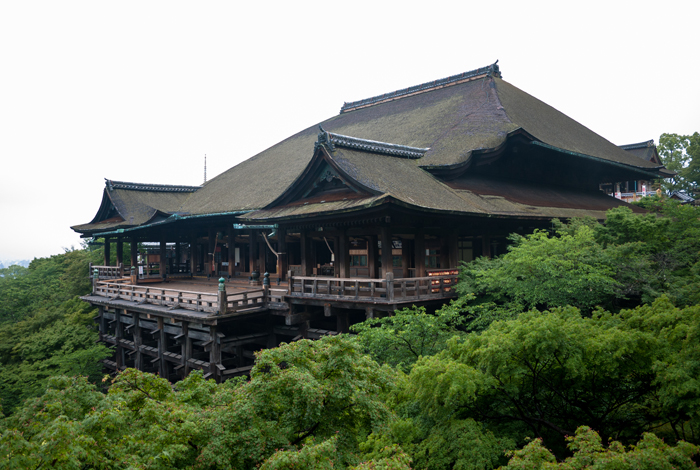
京都のシンボル的存在であり、日本人の多くは修学旅行などで一度は訪れたことがあるのではないだろうか。開創は奈良時代末期の778年(宝亀9年)、音羽山麓から湧き出る清泉が流れる「音羽の滝」に由来し「清水の観音さん」と呼ばれ、古くから広く親しまれてきた。現在の本堂は1633年(寛永10年)に再建され国宝に指定されている。本堂の窓の下には、「弁慶の爪痕」と呼ばれる筋状の深い傷があるが、これはお百度詣りなどで多くの人が夜中に手探りでお参りをしたためについた擦り傷で、古来から庶民に開かれ信心を集めていた証である。本堂から張り出した「清水の舞台」は、急な崖に釘を使わずに巨大な欅の柱を組み上げた「懸造り」で建てられており、高さはビルの4階とほぼ同じ。観音さまに芸能を奉納する場所として、平安時代から雅楽や能、歌舞伎、相撲など、さまざまな芸能が奉納されてきた。この舞台は、410枚以上の檜板を敷き詰めてできており「檜舞台」という言葉はここからきているともいわれている。
Kiyomizu Temple, officially known as Otowa-san Kiyomizu-dera, is one of the most recognizable landmarks in Kyoto. Taking its name from a waterfall in its grounds fed from a clear spring at the foot of Mt. Otowa, the temple known as the ‘Deity of Kiyomizu’ has garnered a wide and loyal following since founding in 778. The current main hall, reconstructed in 1633, is designated as a national treasure. Below the windows of the main hall can be found scratch marks known as ‘Benkei-no-kizuato’, which were created over the years by pilgrims feeling their way to the temple in the dark of night. They are a testimony to the special place held by the temple in the hearts the populace. ‘Kiyomizu-no-butai’ (Kiyomizu Stage) is an elevated platform around four stories high built on the steep hillside using giant zelkova pillars in ‘Kakuzukuri’ style without nails. Decked with 410 hinoki cypress planks lain side by side, the stage has been used since the Heian period to dedicate Gagaku, Noh, Kabuki, Sumo, and other performances to the Kannon deity.

本来の清水寺は、清水山(音羽山)中腹に建てられたため、周りは樹木で生い茂っている。皆が思い浮かべるであろう「清水寺」の情景を再現したかったため、造型の際アレンジを加えた。原型制作:村田 明玄
造形企画製作:株式会社 海洋堂 / 発売日:2018年9月13日 / 価格:1回 500円(税込) / 種類:全9種 ※スペシャルレアカラー含む
-
茶道具 / TEA CEREMONY UTENSILS
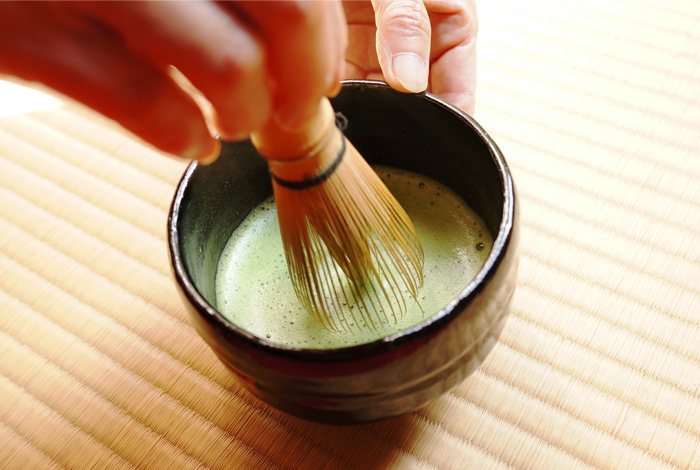
日本独自の文化である「茶道」。京都は、茶道が花開いた土地であり、今も多くの流派の宗家が存在する茶道と縁の深い地である。現在の茶道の原型は、千利休の「侘茶」である。侘茶は、いわゆる「わび・さび」を追求することにより華美な装飾など無駄をすべて省き、それまでの華やかで高級な中国茶器などではなく、竹を割って作った花器や国産の茶器や釜などを使用した。それは、焼物、漆器、指物、石工に至るまで日本の工芸文化の発展に大きな影響を与えた。茶道には数多くの流派があるが、現在の主流は表千家・裏千家・武者小路千家の『三千家』。利休の孫の千宗旦がそれぞれ息子たちに興させた流派で、どれも利休の侘茶の教えを踏襲しているが、茶の点て方や道具、所作にそれぞれの特徴がある。現在の最大流派である裏千家は、茶筅は白竹、薄茶はよく泡立てるのが特徴である。また、三千家の家元が使う茶道具は 「千家十職」といわれる代々伝統を受け継いできた最高峰の職人にのみ制作が許されている。
The Japanese tea ceremony, or ‘Sado’, blossomed in Kyoto, and remains deeply connected to the region. Sen no Rikyu, the father of modern day Sado, developed ‘Wabi-cha’ based on the minimalistic ‘Wabi-Sabi’ aesthetic shunning extravagance and trading ornate Chinese implements for more rustic domestic utensils and kettles. This in turn spurred the development of crafts such as pottery, lacquer-ware, joinery, and stonework in Japan. Today there are many schools of Sado, centered on the three families descended from Sen no Rikyu of ‘Urasenke’, ‘Omotesenke’, and ‘Mushanokojisenke’. The three families are called ‘Sansenke’. Each school has its unique implements, methods and protocol, with the most popular school, Urasenke, using a white bamboo whisk to whisk thin tea to a creamy texture. Tea masters of the Sansenke use utensils made exclusively by ‘Senke-Jisshoku’; the ten highly skilled craftspeople who have inherited traditions through the generations.

茶道の流派はそれぞれあるが、主流の「裏千家」を造型。「裏千家」特有のお抹茶を泡立てた状態を造型で再現した。黒漆の盆に茶器が映える様に塗装した。原型制作:寺岡邦明
造形企画製作:株式会社 海洋堂 / 発売日:2018年9月13日 / 価格:1回 500円(税込) / 種類:全9種 ※スペシャルレアカラー含む
-
舞妓 / MAIKO
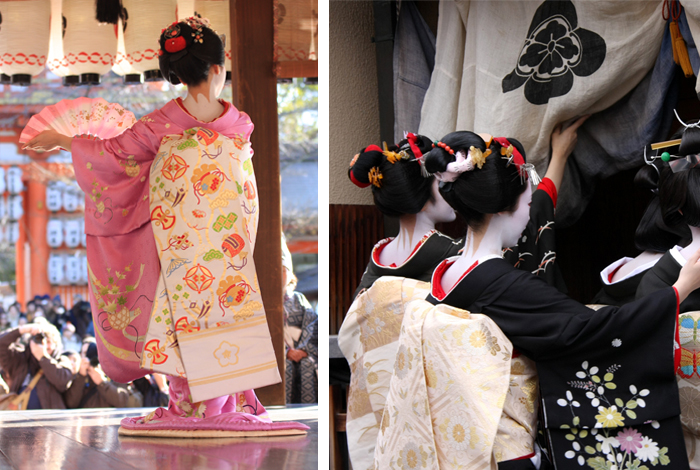
京都といえば、「お茶屋」に「舞妓」。舞妓は京都を象徴するアイコン的存在といえるだろう。舞妓は、先輩の芸妓について「お座敷」での芸や接待を学び、約5年で「襟替え」の儀式を経て「芸妓」になるまでの修練期間。舞妓には見た目にもいくつかの特徴がある。まず、芸妓がかつらを使うのに対して舞妓は地毛で結い上げる。そして、毎月違う花の簪をつけるが、この簪に「ぶら」と呼ばれる花の房がついているのは舞妓の中でも新米の証。また、下唇にだけ紅を塗るのは1年未満の舞妓だけである。足首のあたりまで垂れ下がる「だらりの帯」は、舞妓のための特別な帯で長さが5m以上もあり、この帯を絞めるにはかなりの力がいるため、昔から着付けをするのは男衆の仕事である。京都には、祇園甲部、祇園東、宮川町、先斗町、上七軒の「五花街」と呼ばれる5つの花街がある。夕刻になると置屋からお座敷へと向かう舞妓の姿が見られるかもしれない。ちなみに、昼間に舞妓姿で出歩くことはなく、日中外で見かけるのは舞妓体験の観光客である。
Maiko are apprentice Geisha (known as ‘Geiko’ in Kyoto) who spend about 5 years training under a senior Geisha, learning the arts and protocol to entertain and attend to guests at banquets. While fully fledged Geisha adorn wigs, Maiko have their hair tied up in elaborate styles. They also wear a different floral hairpin each month, decorated with in-season flowers. A small bouquet on the hairpin identifies new Maiko. In the first year of apprenticeship, Maiko only wear lipstick on their lower lip. ‘Darari no obi’, a special obi for Maiko, is over 5m long, requiring great strength to tie: A job traditionally done by men called ‘Otokoshi’. There are 5 ‘Kagai’ (literally means ‘Flower Town’) Geisha districts in Kyoto: Gion-kobu, Gion-higashi, Miyagawa-cho, Ponto-cho, and Kamishichiken. It is not uncommon to see Maiko leaving their dwelling ‘okiya’ for work in the evenings there. As Maiko only venture out at night, anyone dressed such during the day is sure to be a tourist dressing as a Maiko.

京の街をしゃなりしゃなりと歩く舞妓さんを造型で再現。おぼこい、愛らしい姿を見事に造型師が再現している。特徴的な襟足を塗装で再現したので是非とも手にとって見て欲しい。原型制作:村田明玄
造形企画製作:株式会社 海洋堂 / 発売日:2018年9月13日 / 価格:1回 500円(税込) / 種類:全9種 ※スペシャルレアカラー含む
-
京都タワー / KYOTO TOWER
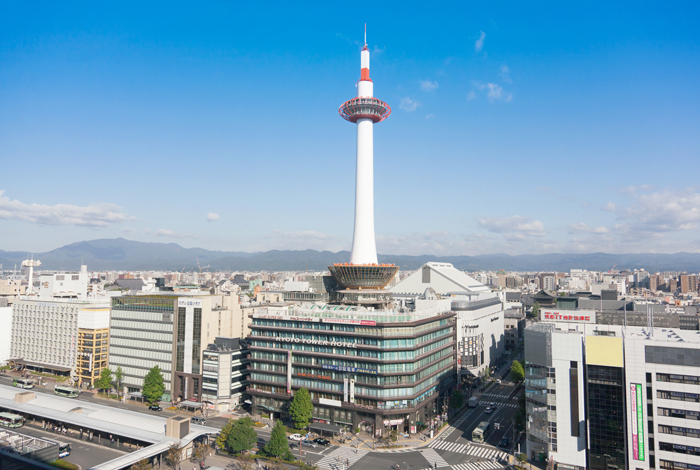
新幹線を降り、烏丸口を出て一番に目に飛び込んでくるランドマーク。地下3階・地上9階のビルの上に立ち、京都の町家の瓦屋根を波に見立てて海のない京都の街を照らす灯台をイメージしたという独特の姿が印象的だ。個性的なのはフォルムだけではない。東京タワーなどと違い一切鉄骨を使っておらず、特殊な鋼板の円筒をつなぎ合わせて造られている。また、一般の建築物の2倍を上回る設計安全率を想定して設計されたため、これまで大型台風や阪神淡路大震災などでも被害を受けることなく、安全性の高さを証明している。地上約100mにある展望室からは碁盤の目の街並みが一望でき、天気の良い日には大阪市内まで見渡すことができる。反対に京都市内には高い建物がないため、嵐山あたりからでも京都タワーが見える。また、夜にはライトアップされ、昼間とは違った美しい姿を見上げてみるのも良い。開業して50年というと京都ではまだまだ新米かもしれないが、今や京都のシンボルのひとつとして愛されている。
After disembarking from the Shinkansen at Kyoto Station, the first landmark that comes into view outside Karasuma Exit is Kyoto Tower. Standing atop a 9-story building, the tower resembles a lighthouse shining the wave-like tiled roofs of landlocked Kyoto City. The tower is not only distinguished by its unique form, but the fact that it is constructed without any metal framework, using only special steel rings stacked on top of each other. Safety is proven by the fact that it has survived numerous natural disasters unscathed. The observation platform around 100m up provides a remarkable view of Kyoto’s grid-like streets, with central Osaka visible in the distance on clear days. Conversely, as there are no other tall buildings in Kyoto, the tower is clearly visible even from the Arashiyama district. The tower is lit up at night, revealing a different beauty from the daytime. The Kyoto Tower has become a cherished symbol of the old capital.

京都タワーの塔体だけでなく京都タワービルまで造型で再現した。この大きさで出来うる限り緻密にし、造型を成立させた。原型制作:寺岡邦明
造形企画製作:株式会社 海洋堂 / 発売日:2018年9月13日 / 価格:1回 500円(税込) / 種類:全9種 ※スペシャルレアカラー含む
-
京野菜 / KYO-YASAI (KYOTO VEGETABLES)
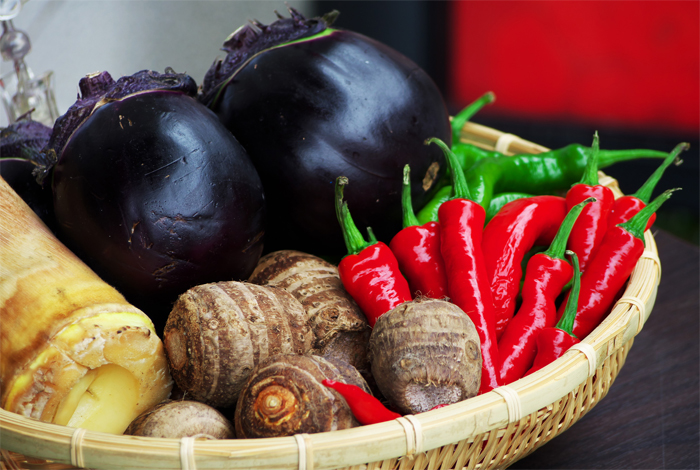
京都の食文化を語る上で欠かせない京野菜。都として栄えた京都には、各地から様々な食材が集まり、朝廷や寺社に献上された。集められた高品質な野菜は、良質な水と豊かな風土に恵まれた京都に根付き、さらに海から遠く海産物が手に入りにくい環境や、寺社の精進料理の発達もあり「京野菜」として発展した。京野菜の代表選手・賀茂なすは、ころんとした丸い形が特徴。肉厚でなめらかな食感で「なすの女王」とも呼ばれ、さまざまな京料理で活躍する。京名物として有名な千枚漬は、秋口から冬にかけて収穫される聖護院かぶらを薄くスライスして漬け込んだもので、京都の冬の味覚として知られている。舞鶴市万願寺地区が発祥の万願寺とうがらしは、長さ15㎝程にもなる大きなとうがらし。とうがらしといっても、いわゆる「鷹の爪」のような辛さはなく、肉厚で甘みがあり彩りも鮮やか。京の都とともに育まれ継承されてきた京野菜。高級料亭の懐石料理から庶民のおばんざいまで、今も昔も変わらず京の食卓を支えている。
Kyoto cuisine could not exist without the city’s traditional vegetables. Having prospered as the nation’s capital, Kyoto was the center to which a rich variety of food was brought from around the country. The high-quality vegetables that were brought to Kyoto took root in the city, blessed as it was with clean water and rich soil. Owing also to the location far from the sea and to the development of ‘Shojin ryori’ (Buddhist food) at temples, these vegetables became what we now know as ‘Kyo-Yasai’. ‘Kamo-nasu’, known as the ‘queen of eggplants’, are used in many Kyoto dishes. Senmaizuke, a famous Kyoto winter specialty, is made by marinating thin slices of ‘Shogoin Turnip’. Manganji chili peppers originate in the Manganji area of Maizuru City, and grow to a whopping 15cm. Though technically a chili, the vibrant green fruit are not spicy, but rather sweet. Kyo-yasai evolved with the ancient capital, and through time catered for not only 'Kaiseki ryori' dishes of high-class restaurant but also ‘Obanzai’ (traditional home style disies of Kyoto).

京野菜を代表する「賀茂なす」「聖護院かぶら」「万願寺とうがらし」を集めた。京野菜の鮮やかな色味が映えるように塗装で工夫をした。原型制作:寺岡邦明
造形企画製作:株式会社 海洋堂 / 発売日:2018年9月13日 / 価格:1回 500円(税込) / 種類:全9種 ※スペシャルレアカラー含む
-
向日葵雄鶏図 / HIMAWARI-YUKEIZU
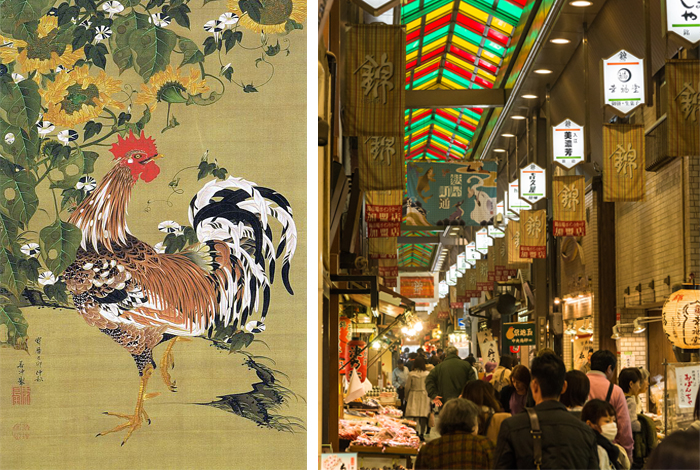
江戸時代中期に活躍し異才を放った画家・伊藤若冲。若冲は1716年、現在も「京都の台所」といわれ賑わう錦小路(錦市場)の青物問屋の長男として生まれた。裕福な商家の跡取りであったため20代で父の跡を継ぎ4代目主人となるが商売には関心がなく、狩野派の門をたたき家業の傍ら画を学んだ。その後40歳頃、弟に家業を譲り画家としての道を歩む。この時代の画の練習法は手本の画を写すことであったが、若冲はそれでは飽きたらず、庭に数十羽の鶏を飼ってひたすら観察し、その「神気」を掴むことによってあらゆる生き物の「神気」を描くことを見出した。若冲は1758年頃から代表作である『動植綵絵』の制作に着手。およそ10年間に渡って制作された。『動植綵絵』とは、動植物を描いた30幅の彩色画で、そのうち23幅が鳥類、とりわけ鶏が多く描かれている。『向日葵雄鶏図』はそのうちのひとつである。完成した『動植綵絵』は若冲と縁の深かった京都・相国寺に寄進され、以後大切に保管されたお陰で今なお鮮やかな色彩のまま残されている。
Ito Jakuchu is a well renowned brilliant artist from the mid-Edo period. He was the eldest son of a vegetable wholesaler in the lively Nishiki-koji area, known to this day as the ‘Pantry of Kyoto’. Heir to a prosperous merchant family, Jakuchu showed little interest in business, and took up the Kano style of painting on the side. At the age of 40 he left the family business to his younger brother and devoted himself to painting. Jakuchu kept several dozen chickens in his garden which he observed constantly. Through his grasp of their ‘life spirit’, he was able to depict the ‘life spirit’ of other animals too. In 1758 he began work on his masterpiece ‘Doshoku Sai-e’(Colorful Realm of Living Beings), which took 10 years to complete. The color painting of plants and animals is comprised of 30 hanging scrolls, 23 of which feature birds, mainly chickens. The Himawari Yukeizu is one of these scrolls.

若冲の代表作「動植綵絵」の一幅「向日葵雄鶏図」の鶏をピックアップ。造型師によって、アートとしてディフォルメされたものである。原型制作:村田明玄
造形企画製作:株式会社 海洋堂 / 発売日:2018年9月13日 / 価格:1回 500円(税込) / 種類:全9種 ※スペシャルレアカラー含む
-
鹿苑寺 金閣 (舎利殿) / KINKAKU-JI TEMPLE

正しくは「北山鹿苑寺」で、臨済宗相国寺派の禅寺。足利三代将軍義満が1397年に造った山荘「北山殿」が、没後に鹿苑寺と名付けられた。金閣をはじめとする庭園・建築は極楽浄土をこの世に現したと言われ、室町幕府は明国との交易を盛んに行い、北山文化の中心地となる。1994年、世界文化遺産登録。
※スペシャルカラーとして、「雪化粧」ver.が出る場合があります。Its actual name is kitayama Rokuon-ji and it’s a Zen Buddhist temple belonging to the Rinzai Shokoku-ji school. The villa Kitayama-dono, built in 1397 by the 3rd shogun Ashikaga Yoshimitsu, was renamed Rokuon-ji after his death. The gardens and architecture, including the Golden Pavilion, were said to embody the Amitabha’s Pure Land in this world and became the center of the Kitayama culture as the Muromachi shogunate conducted lucrative trade with the Ming. It was registered as a World Cultural Heritage site in 1994.
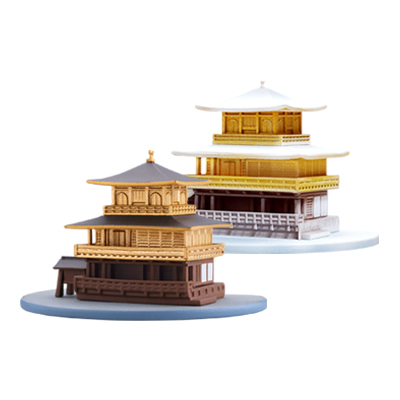
原型制作:平野英之
造形企画製作:株式会社 海洋堂 / 発売日:2018年9月13日 / 価格:1回 500円(税込) / 種類:全9種 ※スペシャルレアカラー含む
-
慈照寺 銀閣 (観音殿) / GINKAKUJI TEMPLE
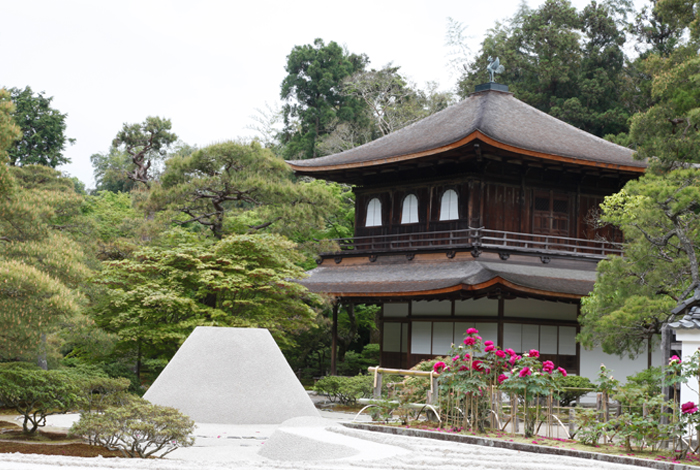
正しくは「東山慈照寺」で、臨済宗相国寺派の禅寺。建立は1482年、足利八代将軍義政による。義政は祖父・三代将軍義満にならい、隠栖生活を過ごすため、銀閣寺の発祥となる山荘「東山殿」を造営した。東山文化の発祥地であり、日本人の近世的生活文化の発端をなしている。1994年、世界文化遺産登録。
Its actual name is Higashiyama Jisho-ji and it’s a Zen Buddhist temple belonging to the Rinzai Shokoku-ji school. Following in the footsteps of the 3rd shogun Yoshimitsu, his grandfather, Yoshimasa constructed the villa Higashiyama-dono, which later became the Ginkaku-ji, for his secluded retirement. This is where the Higashiyama culture originated and it is the starting point for early-modern life and culture in Japan. It was registered as a World Cultural Heritage site in 1994.

原型制作:やすらひろちか
造形企画製作:株式会社 海洋堂 / 発売日:2018年9月13日 / 価格:1回 500円(税込) / 種類:全9種 ※スペシャルレアカラー含む
-
京都フィギュアみやげ / KYOTO FIGURE MIYAGE

京都の名所、物産、文化… バラエティ豊かな“京都名物”を手のひらサイズのフィギュアにしました。
“KYOTO FIGURE MIYAGE” is the miniature figures of famous Kyoto institutions!
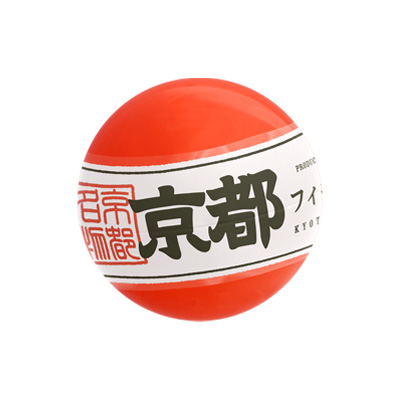
-
造形企画製作:株式会社 海洋堂 / 発売日:2018年9月13日 / 価格:1回 500円(税込) / 種類:全9種 ※スペシャルレアカラー含む